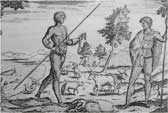Khoikhoin And Their Mode Of Living
|
 |
Hout Bay Museum |
|
 Sir James Lancaster in 1591
Sir James Lancaster in 1591
“We bought an ox for two knives, a sterke (calf) for a knife, and a sheepe for a knife; and some (animals) we bought for lesse value than a knife. The oxen be very large and well fleshed, but not fat. The sheepe are very big and very good meat; they have no woll on their backs, but haire, and great tailes …..” (some accounts describe the tails as being 24 inches in width).
Cornelius Matelief in 1608
“They are large folk, not quite Black, with curly hair, well made both of face and body, and very swift runners so that they can overtake a bull and catch him by the horns or the hind feet and so bring him to a standstill. Because of their greasing they can be smelt fully a rood down-wind ….. Around the body they have a leather thong, to which the tail of a fox or wild-cat is fastened just in front of their privities; and a cloak of a deer or buck skin ….. tied in front just below the chin, and reaching to the buttocks. Many also had dried guts around the neck ….. In one hand each bore a small stick as sick as a finger, and in the other a shor little stick over which the tail of a fox or a cat was drawn, wherewith they chased the flies from their body, this land being so full of flies that it is a marvel. They had shoes under the feet like driars use, but the soles somewhat wider than these. When they speak they cluck in their mouths at every second word, as when one clicks one’s fingers, so that their mouth sounds somewhat like a rattle, no sign of ships or shallops was seen among them.”
Sir Henry Middleton in 1604
“The negroes had their houses, which were no other than afew crocked sticks set in the ground and mattes cast over them ….”, when they want to move “….. they pull downe their houses and make them fast upon their beasts’ backes and drive away”.
Jean-Baptists Tavernier in 1649
“As regards meat, this they eat quite raw as also even fish. As to the guts (intestines) of the beasts, they press these between their fingers to remove the dung, and so eat them. The women commonly put these guts, when dry, around their legs; and especially the guts of such wild beasts as have been taken in the forests by their menfolk; and these serve them as an adornment. They also eat tortoises after they have laid them on the fire until they can take off their shells.”
|
|
|
|
Print this window
|
|

